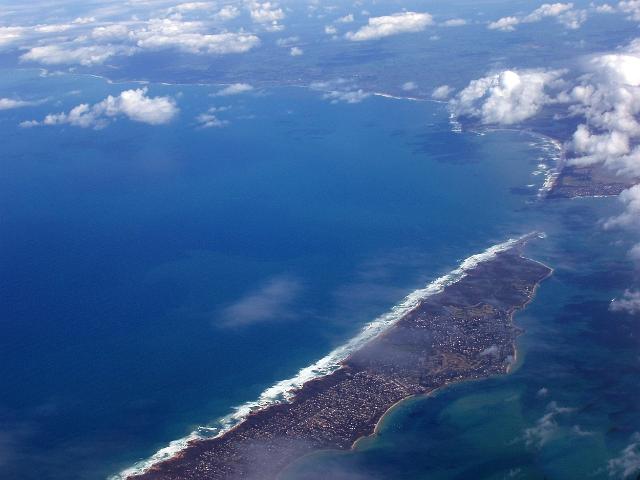AustLit
-
The Wiradjuri nation is the largest cultural footprint in New South Wales, and the second largest group, geographically in Australia.The Wiradjuri people, are known as the 'people of the three rivers' who are originally from the area in Central New South Wales that is bordered by the Lachlan, Macquarie and Murrumbidgee rivers.
The BlackWords team have so far identified over one hundred and fifty authors who identify as Wiradjuri. Prominent Wiradjuri writers include Kevin Gilbert, Kerry Reed-Gilbert, Anita Heiss, Joy Williams, and Tara June Winch. Some of those writers and their works are listed below.
This trail introduces Wiradjuri writers, storytellers, and works.
Readers are advised to explore resources available at the Australian Institute for Aboriginal and Torres Strait Islander Studies (AIATSIS) website and the zoomable map of Indigenous Australia, developed as a part of the Encyclopaedia of Aboriginal Australia.
Discover more Wiradjuri writers | Discover all records related to Wiradjuri in AustLit
Or, conduct your own Advanced Search
Warning: Please be aware that this work may contain images of people who are now deceased.
-
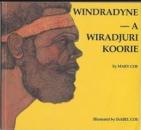 This image has been sourced from WebSee full AustLit entry
This image has been sourced from WebSee full AustLit entryA true account of resistance fighter Windradyne of the Wiradjuri Nation. Windradyne was a warrior and a leader who lived in and around the Eastern Murray River area. He is remembered in this book for his fight for land rights and the wellbeing of approximately 12,000 of his people.
(...more)
Windradyne (c. 1800-1829) was a Wiradjuri resistance leader, who was also known as Saturday, from the upper Macquarie River Region in central-western New South Wales. He was a key protagonist during a period of Aboriginal-settler conflict, known as the 'Bathurst Wars'.
-
 This image has been sourced from Web.See full AustLit entry
This image has been sourced from Web.See full AustLit entry'This book ... is a collection of Minmia's teachings and wisdom. The book is about Traditional teachings of the Lore/law that explains what this land means in every essence. It tells you how to understand your soul journey from the essence of Creation, the dreaming tracks and song lines.
Source: http://www.kuracca.com/ (Sighted: 24/04/2008)
(...more) -
 Image courtesy of publisher's website.See full AustLit entry
Image courtesy of publisher's website.See full AustLit entry'A family memoir charting the political and social changes of Aborigines over the past 40 years. Stan Grant was born in 1963 into the Wiradjuri people - a tribe of warriors who occupied the vast territory of central and southwestern New South Wales. For 100 years the Wiradjuri waged a war against European invasion and settlement. This war has largely been ignored by historians and politicians but will be burnt into the hearts and minds of the Wiradjuri forever. By the time Grant was born, the war against invasion had largely been lost and remnants of the Wiradjuri were scattered among mission camps and the fringes of rural towns.
(...more) -
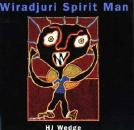 This image has been sourced from Web.See full AustLit entry
This image has been sourced from Web.See full AustLit entryStories behind twenty three paintings by Harry Wedge, topics range from Adam and Eve to Captain Cook, alcohol abuse and religion; Includes a chapter on Harry Wedge's childhood, life on Erambie Mission, Cowra and how he came to be an artist.
(...more) -
See full AustLit entry
Born Colleen Shirley Perry Smith, on Erambie Mission, New South Wales, Shirley Smith AO OBE, or 'Mum Shirl' as she affectionately became known by thousands of people, held many community titles: social worker, activist, humanitarian, foster parent but above all 'Mum' being a true believer in the resilience of the human spirit.
In the mid-1930s, her family moved to Sydney, at which time one of her brothers was jailed. Upon her brother's release, Mum Shirl continued to visit other prisoners, helping them to regain health and focus and finding their families.
Shirley Perry Smith, affectionately known as 'Mum Shirl' had been described as both hero and a saint. She had earned her nickname 'Mum Shirl' through her visits to the inmates after she was allowed by the Department of Corrective Services access to all prisoners in jails in New South Wales.
-
You Kids Count Your Shadows: Hairymen and Other Aboriginal Folklore in New South Wales by Frank Povah
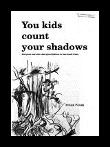 This image has been sourced from Web.'A collection of stories, taken from interviews, which gives an insight into the knowledge and ancient beliefs of the Aboriginal people in NSW.' Source: https://products.schools.nsw.edu.au/prc/home.html (Sighted 12/4/2009). (...more)See full AustLit entry
This image has been sourced from Web.'A collection of stories, taken from interviews, which gives an insight into the knowledge and ancient beliefs of the Aboriginal people in NSW.' Source: https://products.schools.nsw.edu.au/prc/home.html (Sighted 12/4/2009). (...more)See full AustLit entry -
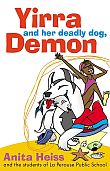 Cover image courtesy ABC.'Yirra's Mum's sick of vacuuming up fur balls, the neighbours are fed up with having their undies nicked from the clothesline, and her Step-Dad just wants his slippers back.See full AustLit entry
Cover image courtesy ABC.'Yirra's Mum's sick of vacuuming up fur balls, the neighbours are fed up with having their undies nicked from the clothesline, and her Step-Dad just wants his slippers back.See full AustLit entry
'If Yirra doesn't find a dog-trainer soon, she'll have to give her beloved Demon to a new family - one who likes dogs who run and dig a lot. Bursting with energy and madcap fun, Yirra and Her Deadly Dog, Demon gives young readers a contemporary view of urban Indigenous life in Sydney.' (Publisher's blurb) (...more)This work was written by Anita Heiss and the students of La Perouse Public School.
-
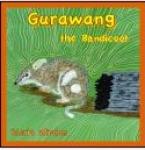 Image courtesy of Black Ink PressGurawang the Bandicoot is the fourth in the Grandma's Farm series by Gloria Whalan. (...more)See full AustLit entry
Image courtesy of Black Ink PressGurawang the Bandicoot is the fourth in the Grandma's Farm series by Gloria Whalan. (...more)See full AustLit entry
This work is the fourth in Grandma's Farm Series by Gloria Whalan.
Other works: Guulaangga the Green Tree Frog | Girrawaa the Goanna | Mermando the Spider
-
 Image courtesy of UQP'Chris Leeton is tormented but also sustained by his growing need to cross over the landscape of his Aboriginal ancestors... In the struggle to keep the family together in Sydney's grim commission housing, schoolboy Chris is tender witness to poverty and despair. In time he comes to understand that they are exiles in their own land. He senses that it is his generation that must cross the bridge back to that landscape which defines his people's existence.' (Source: Publisher's blurb) (...more)See full AustLit entry
Image courtesy of UQP'Chris Leeton is tormented but also sustained by his growing need to cross over the landscape of his Aboriginal ancestors... In the struggle to keep the family together in Sydney's grim commission housing, schoolboy Chris is tender witness to poverty and despair. In time he comes to understand that they are exiles in their own land. He senses that it is his generation that must cross the bridge back to that landscape which defines his people's existence.' (Source: Publisher's blurb) (...more)See full AustLit entry -
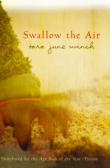 Cover image courtesy UQPSee full AustLit entry
Cover image courtesy UQPSee full AustLit entrySwallow the Air follows the life of 15-year-old May Gibson, an Aboriginal girl from New South Wales whose mother commits suicide. May and her brother go to live with their aunt, but eventually May travels further afield, first to Redfern's Block in Sydney, then to the Northern Territory, and finally into central New South Wales. She travels to escape, but also in pursuit of a sense of her own history, family, and identity.
(...more) -
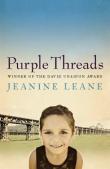 Cover image courtesy of QUP' Purple Threads is a humorous collection of rural yarns by a gifted storyteller. Jeanine Leane grew up on a sheep farm near Gundagai, and the stories are based on her childhood experiences in a house full of fiercely independent women. In between Aunty Boo's surveillance of the local farmers' sheep dip alliance and Aunty Bubby's fireside tales of the Punic Wars, the women offer sage advice to their nieces on growing up as Indigenous girls in a white country town.See full AustLit entry
Cover image courtesy of QUP' Purple Threads is a humorous collection of rural yarns by a gifted storyteller. Jeanine Leane grew up on a sheep farm near Gundagai, and the stories are based on her childhood experiences in a house full of fiercely independent women. In between Aunty Boo's surveillance of the local farmers' sheep dip alliance and Aunty Bubby's fireside tales of the Punic Wars, the women offer sage advice to their nieces on growing up as Indigenous girls in a white country town.See full AustLit entry
The cast of strong Aboriginal women in a rural setting gives a fascinating insight into both Aboriginal and rural life. (...more)Jeanine Leane had won the David Unaipon Award for this work in 2010.
-
 This image has been sourced from Anita Heiss website, 2014.See full AustLit entry
This image has been sourced from Anita Heiss website, 2014.See full AustLit entry'A story about what it means to be a friend … Five women, best friends for decades, meet once a month to talk about books … and life, love and the jagged bits in between. Dissecting each other’s lives seems the most natural thing in the world – and honesty, no matter how brutal, is something they treasure. Best friends tell each other everything, don’t they? But each woman harbours a complex secret and one weekend, without warning, everything comes unstuck.' (Source: Publishers website)
(...more) -
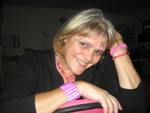 Photograph by the authorSee full AustLit entry
Photograph by the authorSee full AustLit entryElizabeth Hodgson is a Wiradjuri woman, born in Wellington, New South Wales. She spent her childhood in a home for fair-skinned Aboriginal children in a Sydney suburb.
After spending many years travelling, Elizabeth decided to make Wollongong, New South Wales, her home. She has been officially welcomed into Wadi Wadi country and has explored her Aboriginality and spirituality in depth since moving there.
From 2003-2008, Hodgson sat on the Literature and History panel of Arts NSW and the Indigenous Arts Reference Group and during that time she was chair of the South Coast Writers' Centre.
Wiradjuri poet, Elizabeth Hodgson was the winner of the David Unaipon Award in 2007 for her volume of poetry Skin Painting. See also the poem 'I Am a Wiradjuri Woman'. The poem begins... 'I am a Wiradjuri woman my mother is a Wiradjuri woman'.
-
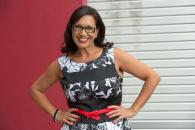 Photo credit: Amanda JamesSee full AustLit entry
Photo credit: Amanda JamesSee full AustLit entryProfessor Anita Heiss is a member of the Wiradjuri nation of central New South Wales and is one of Australia’s most prolific and well-known authors of Aboriginal literature. She has a PhD in Communication and Media which resulted in a history of Indigenous publishing titled Dhuuluu-Yala : To Talk Straight. Other published works include the historical novel Who Am I? : The Diary of Mary Talence : Sydney, 1937, the Macquarie PEN Anthology of Aboriginal Literature, which she co-edited with Peter Minter.
The poem 'Proud to be Koori' was decided to Windradyn, a Wiradjuri warrior. The poem begins... 'I am a Wiradjuri Koori who has survived the shameful massacres'
-
 Image courtesy of author Kerry Reed Gilbert, 2016.See full AustLit entry
Image courtesy of author Kerry Reed Gilbert, 2016.See full AustLit entryA Wiradjuri woman from Central New South Wales Kerry performed and conducted writing workshops nationally and internationally. She was the inaugural Chairperson of the First Nations Australians Writers Network (FNAWN). In 2013 she co-edited a collection of works with the Us Mob Writing (UMW) group ‘By Close of Business, and was co-editor for the Ora Nui Journal, a collaborative collection between First Nations Australia writers and Maori writers.
Kerry Reed-Gilbert daughter of Kevin Gilbert is a well renown writer in her own rights. Reed-Gilbert believes that through her writing she is being 'true' to the meaning of her Totem - the White Cockatoo - which is symbolic of being a Messenger.
Reed-Gilbert is also the editor of many publications from poetry to criticisms.
Her poem 'Wiradjuri Dreamin'' begins... 'In the land of the Wiradjuri'.
-
See full AustLit entry
Joy Williams was born Eileen Williams, daughter of Doretta (Dora) and grand-daughter of Eileen and Harry Williams of Erambie Mission, West Cowra at the Crown Street Women's Hospital, Sydney. As a young child Joy was removed from her Aboriginal family and put in Bomaderry Home. At the age of six she was sent to Lutanda Children's Home run by the Plymouth Brethren, first at Wentworth Falls and later to Pennant Hills, Sydney. Williams was sent to Lutanda, where she was the only Indigenous resident, rather than Cootamundra Aboriginal Girls' Home because of her fair skin.
Joy's poems related to her fight for all stolen children. Her poem 'If Only' from Life, Love and Pain : An Anthology of Poems Written by Stolen Generations Link Up beings... 'If only I had the courage to'.
-
 Courtesy of the NLASince writing the drama The Cake Man, the first black Australian play to be published, televised (1977) and to tour overseas (1982), Robert Merritt has been involved in the production of educational films aimed at rediscovering Aboriginal culture and roots.See full AustLit entry
Courtesy of the NLASince writing the drama The Cake Man, the first black Australian play to be published, televised (1977) and to tour overseas (1982), Robert Merritt has been involved in the production of educational films aimed at rediscovering Aboriginal culture and roots.See full AustLit entry
View the record for The Cake Man and its film adaptation.
-
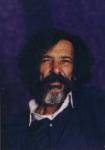 Image courtesy of Eleanor GilbertSee full AustLit entry
Image courtesy of Eleanor GilbertSee full AustLit entryKevin Gilbert (10 July 1933 - 1 April 1993) was born into the Wiradjuri nation on the Kalara riverbank (Lachlan River) in Condobolin, Central New South Wales. During his lifetime, Kevin was a tireless advocate for Aboriginal rights and responsibilities and has left a legacy for others Aboriginal and non-Aboriginal to follow in the struggle for recognition and acceptance of Aboriginal sovereignty and an understanding of the spirituality of the oldest living culture in the world.
The youngest of eight children, Kevin and his siblings became orphaned at a very young age, which exposed the family to the racism of constant police harassment in country towns.
Kevin Gilbert became the first Aboriginal Playwright with his play The Cherry Pickers in 1968, which was also the first play to be performed entirely by an Aboriginal cast.
-
 See full AustLit entry
See full AustLit entryJon Bell is a film and television producer. He grew up in Casino. His mother was Bundjalung and his father Wiradjuri. Bell made the short film And Justice For One before being commissioned to make another for SBS called Two Big Boys. He has also worked as a family case worker for the New South Wales Department of Children's Services.
Among his significant works for television are The Gods of Wheat Street, Cleverman, and The Warriors.
Jon Bell created and wrote the dram series The Gods of Wheat Street with Every Cloud Productions for the ABC's Indigenous Unit.
-
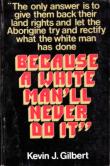 This image has been sourced from online.'First published in 1973, Kevin Gilbert's controversial account of Aboriginal affairs is a damning portrait of the colonisation of Australia by Britain and the problems that have resulted. It tells the story of land theft, attempted racial extermination, oppression, denial of human rights, slavery, ridicule, denigration, inequality and paternalism. And it posits a solution seemingly incomprehensible to many and it examines what the indigenous people really want - land, compensation, discreet non-dictatorial help, but most of all to be left alone by white Australia. (...more)See full AustLit entry
This image has been sourced from online.'First published in 1973, Kevin Gilbert's controversial account of Aboriginal affairs is a damning portrait of the colonisation of Australia by Britain and the problems that have resulted. It tells the story of land theft, attempted racial extermination, oppression, denial of human rights, slavery, ridicule, denigration, inequality and paternalism. And it posits a solution seemingly incomprehensible to many and it examines what the indigenous people really want - land, compensation, discreet non-dictatorial help, but most of all to be left alone by white Australia. (...more)See full AustLit entry -
Disturbing Performances of Race and Nation: King Bunagree, John Noble and Jimmy Clements by Maryrose Casey
See full AustLit entryThis essay is an exploration of the multiple cultural performances and performative Indigenous and non-Indigenous presences competing within events and erased by dominant narratives. The performance and performativity of race, class and culture for both black and white Australians in embodied performances and in accounts as a performative source of ideological meaning-making are critical factors within cross-cultural communications. The focus of this paper is on the dynamic between the Indigenous and non-Indigenous performances and presences within the enactment and documentation of two events separated by 100 years, a nineteenth century anecdote and a twentieth century 'historical' event.
(...more)
'King Billy' (Jimmy Clements) was present at the Opening of the Provisional Parliament House in Canberra on 9 May 1927, a controversial gesture that has since been interpreted as the first land-rights demonstration.
-
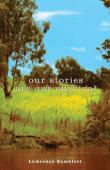 Image courtesy of Publisher websiteSee full AustLit entry
Image courtesy of Publisher websiteSee full AustLit entry'This book examines physical activities and sports important to Erambie Kooris, including the animated form of storytelling that has a significant physical performance component, games such as rounders and skipping, as well as bare knuckle fighting. It also examines the connections between physical activities and sports as cultural practices.' (Source: Koori Mail, issue 548 2013)
(...more) -
Originally compiled by Irene Howe in 2014. Revised and updated in 2019.
You might be interested in...

